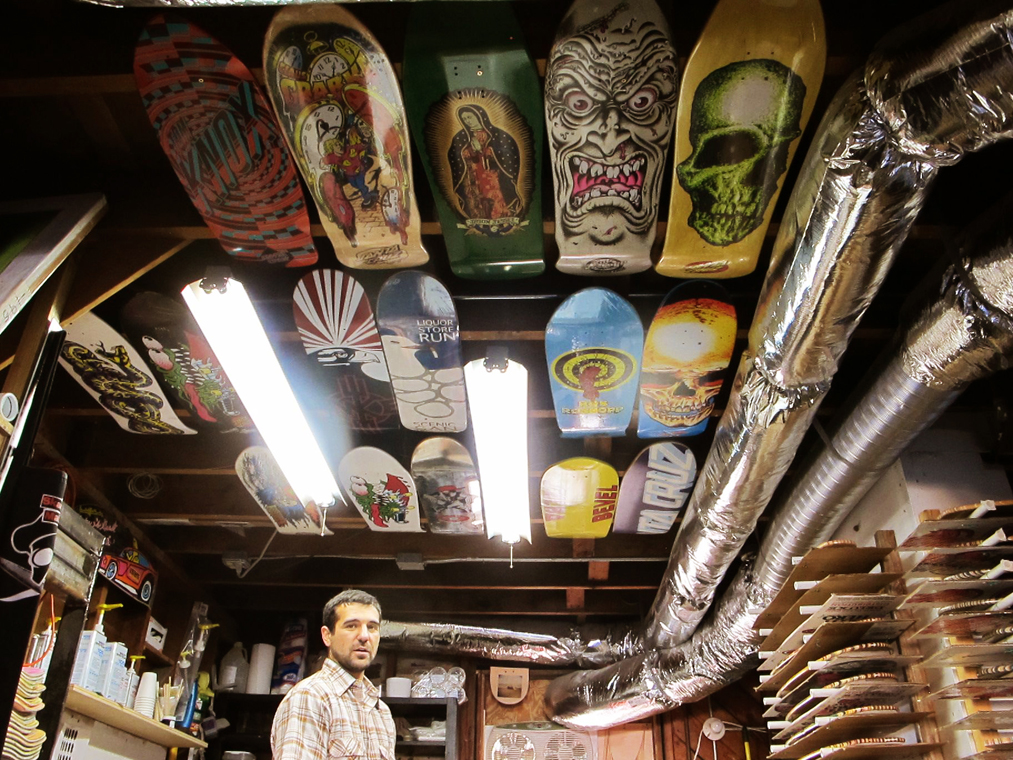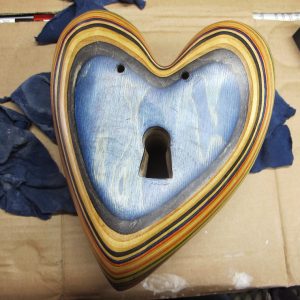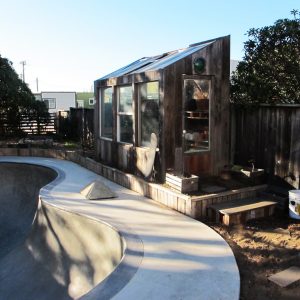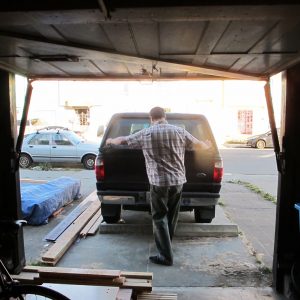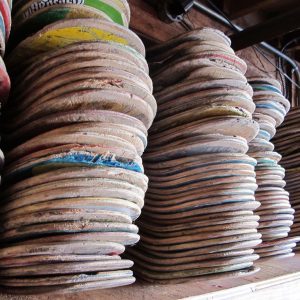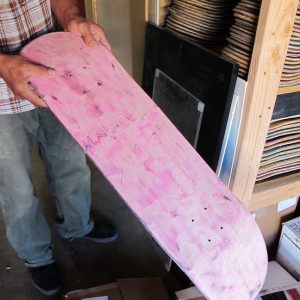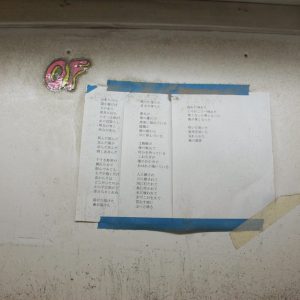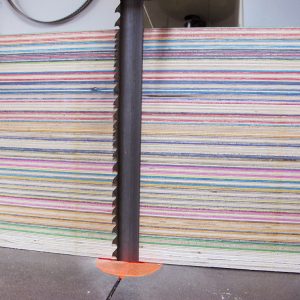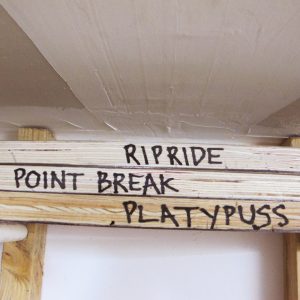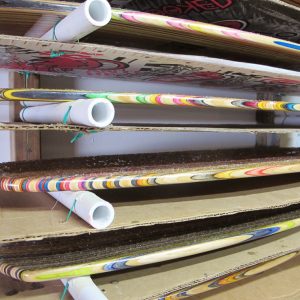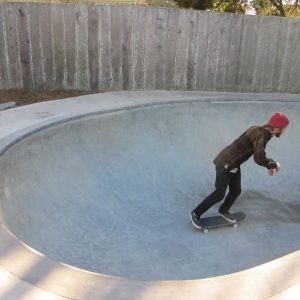From his home tucked away in the hazy outer Sunset neighborhood of San Francisco, George Rocha takes broken skateboards and gives them a second life. Founded only a year ago, Iris skateboards has achieved cult-like status within the industry as companies, including Deluxe, FTC and NHS, regularly donate boards to his cause, offering not only a growing business for George to cultivate, but also a new school approach to taking responsibility for excessive waste within the action sports sector.
When I met George, I knew that I liked him right away. He is a fellow East Coaster with a passion for working with his hands, surfing, snowboarding and skating. He also has a sweet dog named Reese, who just happens to be the resident shop dog and official “lifeguard” of the right-handed kidney shaped concrete bowl that George meticulously poured with friends in his backyard. For most of the studio visit, we talked a lot about old-school traditions and a hardworking sensibility, which is something I can totally relate to. George values, above all, an honest day’s work, commitment and reliability from the guys that he brings under his wing. Whether it is building skateparks or making boards, those kind of characteristics are essential and non-negotiable when it comes to the daily grind.
What separates George from the rest of the artisans making objects out of reclaimed boards is pretty simple; everything he makes is made to function. He may not be the only one dabbling with these techniques, or even the first to “sculpt skateboards” as he likes to call it, but what he is doing is making it useful, rideable and purposeful, which in turn adds value to the industry and the community.
How long have you been skateboarding?
Skateboarding is my life. I have been skateboarding for 33 years and building skateparks for 20 years.
How did you segue from building skateparks to rideable works of art?
The first thing I ever made, before I started making skateboards, was a heart for my ex-girlfriend. Then I decided to make a real skateboard, and even tried to fabricate the trucks. I figured out real quick that the trucks were super hard to make without the right tooling, so I decided to just stick to the boards and I realized that I was onto something. The first board I shaped was inspired by a skateboard my parents bought me at a yard sale in 1980.
All your boards are made from broken decks. Are you a “greenie”?
I am all for being eco-conscious, but I am not a champion of it. I think about it when I make something, as most people should, but I can’t lie and say that I was driven by keeping things out of the landfill. I just wanted to sculpt skateboards and this was the next logical step.
How did you come up with your signature shape?
I had made ones with kicktails, but they weren’t durable enough in the beginning, the mission was to make a ’70s style cruiser, so I started exploring other materials that were borrowed from surfboard shaping. By glassing the top and bottom with cloth and resin I was able to make a stronger board. For grip, I use recycled crushed glass on the top of my boards because conventional grip tape would cover up the beauty of the colored veneers.
How did you decide on the name Iris Skateboards?
I came up with a list of names but they were either already taken or just weren’t the right fit. People describe my boards to be “rainbow-like”, so I researched rainbows and there it was. Iris! Iris is the Greek goddess of rainbows and the sea, perfect. I immediately went to work and produced the first three shapes that are still available today. The Ripride, The Point Break, and the Platypuss.
Do you find that people are drawn to Iris because retro boards are so trendy right now?
Well, people act like it is a fad, but it isn’t. It is like the same thing with old cars, saying that they are fad, people just like to ride things from the past and enjoy them for what they were. I think there is a certain nostalgia attached to it for sure, though. Just because you have a brand new car, doesn’t mean you don’t want to drive a vintage classic.
Skateboarding is gnarly. When you get a normal skateboard in your hand and you know what it is capable of doing, you feel like a tool if you are just riding down the street when everyone is flipping and ollying. These boards are made just to cruise, so if you use it the way they are intended to be used then you might feel like less of a barney.
How did you get involved with the New West Coast Design 2 Exhibit at the Museum of Craft and Design?
Someone from the Museum of Craft and Design went to Deluxe Skateshop and saw my board on the rack and asked about it, so that was how they found me. I had been talking to some galleries at the time about doing a show, which was a total coincidence. When I went to check out the museum, there was a Herman Miller exhibit up and it was like “holy shit, my stuff is going to be in here?” and it really sunk in. The boards I made for them, I really took my time. They were really special.
Do you see yourself as a craftsman, as an artist, or a maker?
I would say a craftsman, because I am a functional artist. It has to “do” something; I don’t just want to make things to sit on a shelf unless it is for a specific purpose like the pieces I make for charities. I have to believe in the usage of it. If someone told me I could make a million dollars making yo-yos, I would be like, “Get someone else to make it. I don’t yo-yo.” I wouldn’t do it. Then all of a sudden it turns into a job and you are just watching the clock. My full time job is still building skateparks, but when I come home, I put time into the shop everyday and I enjoy it.
Tell me about your process?
I unload my truck, usually the broken boards come in boxes from Deluxe, FTC and NHS. Once they are sorted, I remove all the artwork and they get stacked and glued. They get lined up randomly so I try not to control the color. The randomness makes it rad–you can tell when they come from the same stack, but they are subtlety different from one another so no two are alike. It is almost impossible to make two identical Iris boards, which is awesome because your board is your board.
It takes a stack of 20 used boards to get 12 Iris skateboards. It takes me about a week to make 12 and I handle all production and sales myself. I have dozens of retailers all over the world. Mostly in the United States and Japan.
For more info on how to get your hands on a board, head over to irisskateboards.com or follow George and Reese on insta @iris_skateboards. The New West Coast Design 2 exhibit at the Museum of Craft and Design is also on display until Jan 5, 2014, so you can check out the finished product in person.
XX Jeanine
